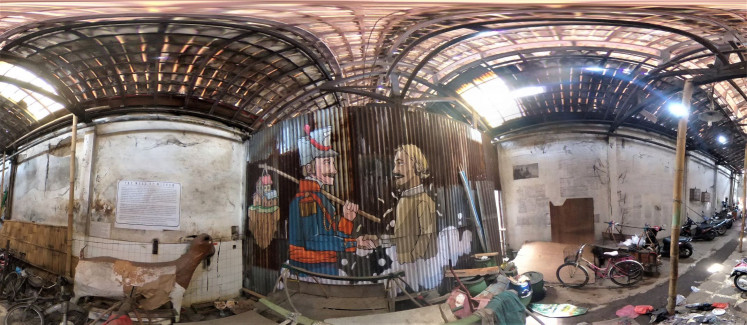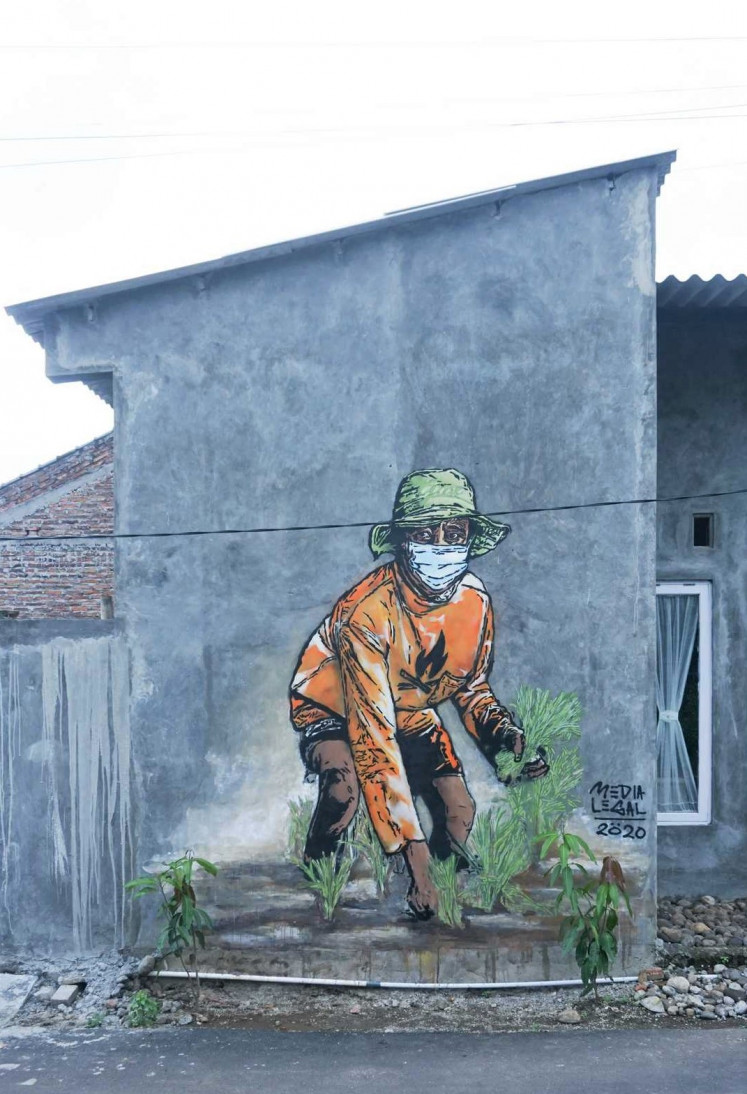Popular Reads
Top Results
Can't find what you're looking for?
View all search resultsPopular Reads
Top Results
Can't find what you're looking for?
View all search resultsArt exhibition tells stories about kampung, climate change
An art project has involved the residents of eight kampung in Semarang.
Change text size
Gift Premium Articles
to Anyone
 Welcome gate: The murals in Kampung Jatiwayang not only add aesthetics to the urban neighborhood but also a display of appreciation to tradition and nature. 'Wayang Sambit' (left) is spray paint art created by Poharin and Alodia, while 'Bukit’s Heart' (right) was made by Valeriana Grajales. (Courtesy of Kolektif Hysteria/National Gallery of Indonesia)
Welcome gate: The murals in Kampung Jatiwayang not only add aesthetics to the urban neighborhood but also a display of appreciation to tradition and nature. 'Wayang Sambit' (left) is spray paint art created by Poharin and Alodia, while 'Bukit’s Heart' (right) was made by Valeriana Grajales. (Courtesy of Kolektif Hysteria/National Gallery of Indonesia)
T
he National Gallery of Indonesia has held a virtual exhibition of murals and installation art by Semarang-based artists collective Kolektif Hysteria, exploring the urban kampung of the Central Java capital city.
Titled “Udan Salah Mongso” (Rain in the Wrong Season), the exhibition looked at how the artists responded to the global issue of climate change and the human activities that caused this.
Curator Adin of Hysteria said the phrase was used by Javanese villagers when commenting on changes to the planting and harvesting seasons as a result of unpredictable starts to the rainy season.
Traditionally, the Javanese people schedule the growing season within rendheng (rainy season) from October to April and ketigo (dry season) from April to October.
“The theme reflects today’s situation in relation to climate change and the magnitude of its adverse impacts on the living ecosystem, including during this pandemic,” he said in a curatorial statement made available to The Jakarta Post.
Starting Dec. 1, the works of the artists in collaboration with the kampung residents will be available on the National Gallery’s online exhibition platform galnasonline.id and can be viewed in virtual reality (VR).
The mural and installation artworks were situated in eight urban neighborhoods in Bandarharjo, Bustaman, Jatiwayang-Ngemplak Simongan, Kemijen, Petemesan, Randusari-Nongkosawit, Sendangguwo, and Subali-Krapyak.
One mural by the collective, Ingon (Pet) in Kemijen, depicts a running motor with four furry limbs sitting on a shrinking snowy islet in the middle of a sea.
Do not park: A wall installation in Kampung Petemasan called 'Untitled' by UPTOWN CREW depicts the artists’ opinion on climate change. (Courtesy of Kolektif Hysteria/National Gallery of Indonesia)An installation made by Uptown Crew in Petemasan, Untitled, shows a bicycle hanging on a painted wall, appearing as if it is tied to balloons and floating in the air with a cart and a minivan parked beneath.
In the curatorial note, Adin and co-curator Pujo Nugroho said that the world was currently finding new ways to counter anthropocentrism – the belief that humans are the most important entity in the universe – by revisiting pagan beliefs such as animism and dynamism as a human approach to nature instead of an approach seen as one of heresy or idolatry.
“The rituals are still alive in kampung that sustain the tradition of appreciating nature. However, the lack of intellectuals to critically evaluate this phenomenon has made this tradition habitual without the context of the current situation,” it said.
The exhibition was the 21st edition of the National Gallery’s Exhibition Tour program, which has been held since 2006 in different cities of Indonesia.
This year, according to National Gallery director Pustanto, instead of holding the exhibition in Semarang as originally planned, it brought the artworks to the digital realm.
“We chose to present Kolektif Hysteria and Semarang because both are important entities in our glossary of the art collective,” he said.
“The exhibition hopefully can contribute to the growing passion for collaboration and finding the identity of Indonesia’s arts.”
Safe farming: A mural shows a farmer planting paddy seedlings on a house wall in Kampung Sendangguwo. The mural, part of the biennial art project Penta Klabs by the artist collective Kolektif Hysteria, was displayed virtually at the National Gallery of Indonesia’s digital exhibition platform. (Courtesy of Kolektif Hysteria/National Gallery of Indonesia)The exhibition also served as a curatorial framework for the third installment of the Kolektif Hysteria’s biennial event, Penta Klabs.
The communal art project, first held in 2016, sees artists chose a specific site for their activities with the involvement of local residents.
Its maiden event “Narasi Kemijen” (The Stories of Kemijen) focused on the resilience of residents in the Kemijen subdistrict in facing coastal flooding every year.
In 2018, the artist collective responded to land-use change in Semarang with the art project “Sedulur Banyu” (Thicker than Water), which focused on the water ecosystem in the upstream Kampung Randusari.
The archives of the art projects could also be viewed at the virtual exhibition. (ste)













